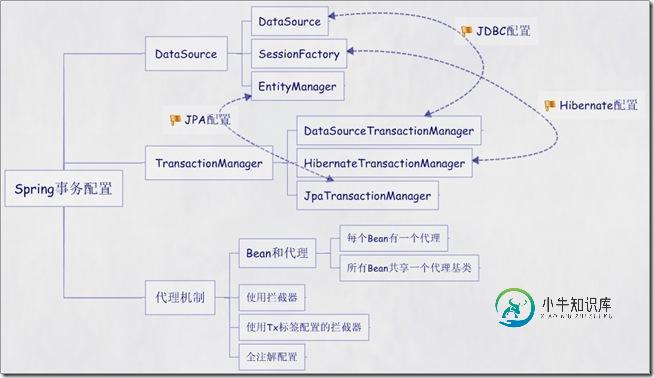详解Spring配置事务的五种方式
Spring配置文件中关于事务配置总是由三个组成部分,分别是 DataSource 、TransactionManager 和 代理机制 这三部分,无论哪种配置方式,一般变化的只是代理机制这部分。
DataSource、TransactionManager这两部分只是会根据数据访问方式有所变化,比如使用Hibernate进行数据访问时,DataSource实际为SessionFactory,TransactionManager的实现为HibernateTransactionManager。
具体如下图:

根据代理机制的不同,总结了五种Spring事务的配置方式,配置文件如下:
第一种方式:每个Bean都有一个代理
<?xml version="1.0" encoding="UTF-8"?> <beans xmlns="http://www.springframework.org/schema/beans" xmlns:xsi="http://www.w3.org/2001/XMLSchema-instance" xmlns:context="http://www.springframework.org/schema/context" xmlns:aop="http://www.springframework.org/schema/aop" xsi:schemaLocation="http://www.springframework.org/schema/beans http://www.springframework.org/schema/beans/spring-beans-2.5.xsd http://www.springframework.org/schema/context http://www.springframework.org/schema/context/spring-context-2.5.xsd http://www.springframework.org/schema/aop http://www.springframework.org/schema/aop/spring-aop-2.5.xsd"> <bean id="sessionFactory" class="org.springframework.orm.hibernate3.LocalSessionFactoryBean"> <property name="configLocation" value="classpath:hibernate.cfg.xml" /> <property name="configurationClass" value="org.hibernate.cfg.AnnotationConfiguration" /> </bean> <!-- 定义事务管理器(声明式的事务) --> <bean id="transactionManager" class="org.springframework.orm.hibernate3.HibernateTransactionManager"> <property name="sessionFactory" ref="sessionFactory" /> </bean> <!-- 配置DAO --> <bean id="userDaoTarget" class="com.bluesky.spring.dao.UserDaoImpl"> <property name="sessionFactory" ref="sessionFactory" /> </bean> <bean id="userDao" class="org.springframework.transaction.interceptor.TransactionProxyFactoryBean"> <!-- 配置事务管理器 --> <property name="transactionManager" ref="transactionManager" /> <property name="target" ref="userDaoTarget" /> <property name="proxyInterfaces" value="com.bluesky.spring.dao.GeneratorDao" /> <!-- 配置事务属性 --> <property name="transactionAttributes"> <props> <prop key="*">PROPAGATION_REQUIRED</prop> </props> </property> </bean> </beans>
第二种方式:所有Bean共享一个代理基类
<?xml version="1.0" encoding="UTF-8"?> <beans xmlns="http://www.springframework.org/schema/beans" xmlns:xsi="http://www.w3.org/2001/XMLSchema-instance" xmlns:context="http://www.springframework.org/schema/context" xmlns:aop="http://www.springframework.org/schema/aop" xsi:schemaLocation="http://www.springframework.org/schema/beans http://www.springframework.org/schema/beans/spring-beans-2.5.xsd http://www.springframework.org/schema/context http://www.springframework.org/schema/context/spring-context-2.5.xsd http://www.springframework.org/schema/aop http://www.springframework.org/schema/aop/spring-aop-2.5.xsd"> <bean id="sessionFactory" class="org.springframework.orm.hibernate3.LocalSessionFactoryBean"> <property name="configLocation" value="classpath:hibernate.cfg.xml" /> <property name="configurationClass" value="org.hibernate.cfg.AnnotationConfiguration" /> </bean> <!-- 定义事务管理器(声明式的事务) --> <bean id="transactionManager" class="org.springframework.orm.hibernate3.HibernateTransactionManager"> <property name="sessionFactory" ref="sessionFactory" /> </bean> <bean id="transactionBase" class="org.springframework.transaction.interceptor.TransactionProxyFactoryBean" lazy-init="true" abstract="true"> <!-- 配置事务管理器 --> <property name="transactionManager" ref="transactionManager" /> <!-- 配置事务属性 --> <property name="transactionAttributes"> <props> <prop key="*">PROPAGATION_REQUIRED</prop> </props> </property> </bean> <!-- 配置DAO --> <bean id="userDaoTarget" class="com.bluesky.spring.dao.UserDaoImpl"> <property name="sessionFactory" ref="sessionFactory" /> </bean> <bean id="userDao" parent="transactionBase" > <property name="target" ref="userDaoTarget" /> </bean> </beans>
第三种方式:使用拦截器
<?xml version="1.0" encoding="UTF-8"?> <beans xmlns="http://www.springframework.org/schema/beans" xmlns:xsi="http://www.w3.org/2001/XMLSchema-instance" xmlns:context="http://www.springframework.org/schema/context" xmlns:aop="http://www.springframework.org/schema/aop" xsi:schemaLocation="http://www.springframework.org/schema/beans http://www.springframework.org/schema/beans/spring-beans-2.5.xsd http://www.springframework.org/schema/context http://www.springframework.org/schema/context/spring-context-2.5.xsd http://www.springframework.org/schema/aop http://www.springframework.org/schema/aop/spring-aop-2.5.xsd"> <bean id="sessionFactory" class="org.springframework.orm.hibernate3.LocalSessionFactoryBean"> <property name="configLocation" value="classpath:hibernate.cfg.xml" /> <property name="configurationClass" value="org.hibernate.cfg.AnnotationConfiguration" /> </bean> <!-- 定义事务管理器(声明式的事务) --> <bean id="transactionManager" class="org.springframework.orm.hibernate3.HibernateTransactionManager"> <property name="sessionFactory" ref="sessionFactory" /> </bean> <bean id="transactionInterceptor" class="org.springframework.transaction.interceptor.TransactionInterceptor"> <property name="transactionManager" ref="transactionManager" /> <!-- 配置事务属性 --> <property name="transactionAttributes"> <props> <prop key="*">PROPAGATION_REQUIRED</prop> </props> </property> </bean> <bean class="org.springframework.aop.framework.autoproxy.BeanNameAutoProxyCreator"> <property name="beanNames"> <list> <value>*Dao</value> </list> </property> <property name="interceptorNames"> <list> <value>transactionInterceptor</value> </list> </property> </bean> <!-- 配置DAO --> <bean id="userDao" class="com.bluesky.spring.dao.UserDaoImpl"> <property name="sessionFactory" ref="sessionFactory" /> </bean> </beans>
第四种方式:使用tx标签配置的拦截器
<?xml version="1.0" encoding="UTF-8"?> <beans xmlns="http://www.springframework.org/schema/beans" xmlns:xsi="http://www.w3.org/2001/XMLSchema-instance" xmlns:context="http://www.springframework.org/schema/context" xmlns:aop="http://www.springframework.org/schema/aop" xmlns:tx="http://www.springframework.org/schema/tx" xsi:schemaLocation="http://www.springframework.org/schema/beans http://www.springframework.org/schema/beans/spring-beans-2.5.xsd http://www.springframework.org/schema/context http://www.springframework.org/schema/context/spring-context-2.5.xsd http://www.springframework.org/schema/aop http://www.springframework.org/schema/aop/spring-aop-2.5.xsd http://www.springframework.org/schema/tx http://www.springframework.org/schema/tx/spring-tx-2.5.xsd"> <context:annotation-config /> <context:component-scan base-package="com.bluesky" /> <bean id="sessionFactory" class="org.springframework.orm.hibernate3.LocalSessionFactoryBean"> <property name="configLocation" value="classpath:hibernate.cfg.xml" /> <property name="configurationClass" value="org.hibernate.cfg.AnnotationConfiguration" /> </bean> <!-- 定义事务管理器(声明式的事务) --> <bean id="transactionManager" class="org.springframework.orm.hibernate3.HibernateTransactionManager"> <property name="sessionFactory" ref="sessionFactory" /> </bean> <tx:advice id="txAdvice" transaction-manager="transactionManager"> <tx:attributes> <tx:method name="*" propagation="REQUIRED" /> </tx:attributes> </tx:advice> <aop:config> <aop:pointcut id="interceptorPointCuts" expression="execution(* com.bluesky.spring.dao.*.*(..))" /> <aop:advisor advice-ref="txAdvice" pointcut-ref="interceptorPointCuts" /> </aop:config> </beans>
第五种方式:全注解
<?xml version="1.0" encoding="UTF-8"?> <beans xmlns="http://www.springframework.org/schema/beans" xmlns:xsi="http://www.w3.org/2001/XMLSchema-instance" xmlns:context="http://www.springframework.org/schema/context" xmlns:aop="http://www.springframework.org/schema/aop" xmlns:tx="http://www.springframework.org/schema/tx" xsi:schemaLocation="http://www.springframework.org/schema/beans http://www.springframework.org/schema/beans/spring-beans-2.5.xsd http://www.springframework.org/schema/context http://www.springframework.org/schema/context/spring-context-2.5.xsd http://www.springframework.org/schema/aop http://www.springframework.org/schema/aop/spring-aop-2.5.xsd http://www.springframework.org/schema/tx http://www.springframework.org/schema/tx/spring-tx-2.5.xsd"> <context:annotation-config /> <context:component-scan base-package="com.bluesky" /> <tx:annotation-driven transaction-manager="transactionManager"/> <bean id="sessionFactory" class="org.springframework.orm.hibernate3.LocalSessionFactoryBean"> <property name="configLocation" value="classpath:hibernate.cfg.xml" /> <property name="configurationClass" value="org.hibernate.cfg.AnnotationConfiguration" /> </bean> <!-- 定义事务管理器(声明式的事务) --> <bean id="transactionManager" class="org.springframework.orm.hibernate3.HibernateTransactionManager"> <property name="sessionFactory" ref="sessionFactory" /> </bean> </beans>
此时在DAO上需加上@Transactional注解,如下:
package com.mktao.spring.dao;
import java.util.List;
import org.hibernate.SessionFactory;
import org.springframework.beans.factory.annotation.Autowired;
import org.springframework.orm.hibernate3.support.HibernateDaoSupport;
import org.springframework.stereotype.Component;
import com.bluesky.spring.domain.User;
@Transactional
@Component("userDao")
public class UserDaoImpl extends HibernateDaoSupport implements UserDao {
public List<User> listUsers() {
return this.getSession().createQuery("from User").list();
}
...
}
以上就是本文的全部内容,希望对大家的学习有所帮助,也希望大家多多支持小牛知识库。
-
本文向大家介绍Spring事务Transaction配置的五种注入方式详解,包括了Spring事务Transaction配置的五种注入方式详解的使用技巧和注意事项,需要的朋友参考一下 前段时间对spring的事务配置做了比较深入的研究,在此之间对Spring的事务配置虽说也配置过,但是一直没有一个清楚的认识。通过这次的学习发觉Spring的事务配置只要把思路理清,还是比较好掌握的。 总结如下: S
-
本文向大家介绍详解spring 配置的两种方式:JAVA配置和注解配置,包括了详解spring 配置的两种方式:JAVA配置和注解配置的使用技巧和注意事项,需要的朋友参考一下 众所周知,spring自从3.0开始以后,就全面推荐使用配置的方式进行代码编写了,这种方式确实可以避免了之前一个项目里面一大堆XML的情况,毕竟XML的可读性实在不怎么样,而且一会写JAVA,一会写XML,确实还是蛮麻烦的
-
本文向大家介绍Spring中的事务操作、注解及XML配置详解,包括了Spring中的事务操作、注解及XML配置详解的使用技巧和注意事项,需要的朋友参考一下 事务 事务全称叫数据库事务,是数据库并发控制时的基本单位,它是一个操作集合,这些操作要么不执行,要么都执行,不可分割。例如我们的转账这个业务,就需要进行数据库事务的处理。 转账中至少会涉及到两条 SQL 语句: 上面这两条 SQL 就可以要看成
-
本文向大家介绍详解PHP实现定时任务的五种方法,包括了详解PHP实现定时任务的五种方法的使用技巧和注意事项,需要的朋友参考一下 定时运行任务对于一个网站来说,是一个比较重要的任务,比如定时发布文档,定时清理垃圾信息等,现在的网站大多数都是采用PHP动态语言开发的,而对于PHP的实现决定了它没有Java和.Net这种AppServer的概念,而http协议是一个无状态的协议,PHP只能被用户触发,被
-
上一节:分分钟部署一个Hexo环境 准备启程 一旦安装了Hexo,运行以下命令初始化Hexo在目录 $ hexo init <folder> $ cd <folder> $ cnpm install 一旦初始化,你的项目文件夹是这个样子: . ├── _config.yml ├── package.json ├── scaffolds ├── scripts ├── source | ├──
-
本文向大家介绍详解Java实现单例的五种方式,包括了详解Java实现单例的五种方式的使用技巧和注意事项,需要的朋友参考一下 1. 什么是单例模式 单例模式指的是在应用整个生命周期内只能存在一个实例。单例模式是一种被广泛使用的设计模式。他有很多好处,能够避免实例对象的重复创建,减少创建实例的系统开销,节省内存。 单例模式的要求有三点: 某个类只能有一个实例 它必须自行创建这个实例 他必须自行向整个系

